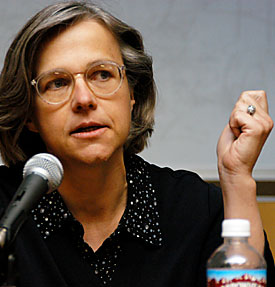 |
|
WILL SEBERGER/Arizona Daily Wildcat
|
Bobbie Jo Buel, managing editor for the Arizona Daily Star, answers a question about wartime media coverage at last night.
|
|
By Devin Simmons
Arizona Daily Wildcat
Tuesday April 15, 2003
Members of the local media received criticism last night over war coverage at a panel coordinated by the Alliance for Peace and Justice in the Middle East.
"In general the U.S. media is not doing an A-plus job covering all aspects of this war," said Leila Hudson, a professor of Near Eastern studies. "That is especially disturbing in a democracy."
Hudson, KOLD TV anchor Randy Garsee, and Bobbie Jo Buel, managing editor of The Arizona Daily Star, took part in the panel discussion, entitled "Media in the Time of War".
The event was meant to educate people about the way in which the media obtains information and then decides what to broadcast, said Noah Haiduc-Dale, vice president of APJME.
Some of the 60-plus audience members took the opportunity to vent frustrations over what they viewed as biased coverage, calling the coverage of the war in the U.S. "cotton candy" and expressing disgust with Americans over their ignorance of the Middle East.
The problem is not with journalists, Hudson said. The media industry has been constrained by the three T's: taste, tone and time. Viewers in America have been denied graphic images of war, she said, adding that cable news has taken a rigid tone out of fear that not doing so would indicate a lack of support for troops.
Sept. 11 caused a knee-jerk reaction in the U.S. media, Garsee said. Images like that of a U.S. solidier being dragged through the streets of Mogadishu, Somalia in 1993, are no longer acceptable to viewers.
"It is wrong when you can't see when terrorism is terrorism and war is war," Garsee said. "But we have to give the people the information that they want to know."
Garsee, who went to Kuwait to cover the first weeks of the war for KOLD, said the real power is with the viewers, and people in America only want to see certain things.
Buel echoed her frustrations making reference to a photo that ran in the Star, which showed a downed U.S. helicopter with Iraqi civilians celebrating around it. The photo received the most feedback of any of the paper's war coverage, mostly from people who were angry and called the photo anti-American.
"We are a business and big news sells," Jo Buel said. "Getting readers is the key."

